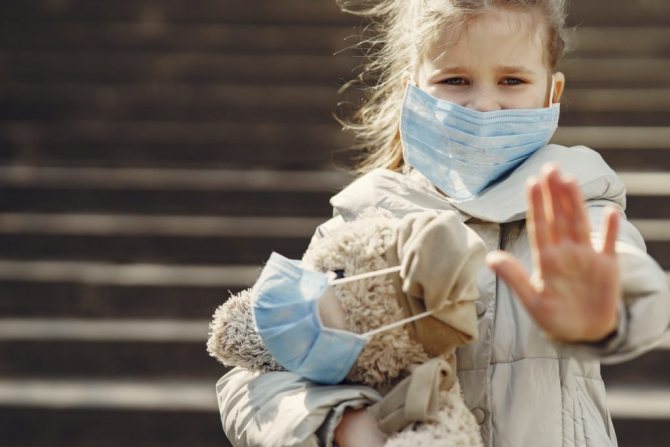In medicine, there are two forms of flu vaccinations:
- injections;
- nasal drops.
Until recently, the second form of the vaccine was considered the most acceptable, since it duplicated the process of natural entry of the influenza virus into the body and provoked an appropriate immune response. But lately, flu shots in the form of nasal drops have hardly been used. The fact is that they, compared to injection vaccinations, caused a significantly greater number of side effects, including allergic reactions. This became the reason for their complete abandonment. Therefore, when considering the question of where to get a flu shot, we will talk exclusively about the injection form of the vaccine.
What is the flu and why is it dangerous?
Influenza is a viral infection caused by viruses of the orthomyxovirus genus. There are only 4 monotypic genera of such viruses: A, B, C and D. Moreover, the first two are considered the most dangerous - they are capable of causing seasonal epidemics - large outbreaks of morbidity, in which cases of infection spread not only throughout the country, but also in the territory of neighboring states. In the northern hemisphere, where we live, the incidence of influenza usually increases in the fall and tapers off in the summer. Looking at the big picture, the seasonality of influenza is also evident (Figure 1).
Figure 1. Reported cases of influenza worldwide in 2021. Source: WHO/Statista 2020
Influenza is an acute disease accompanied by damage to the respiratory tract. The disease has a very short incubation period - from 3 to 24 hours. Flu can be accompanied by both specific and general symptoms.
- Specific: dry painful cough, sore throat, sore throat, hoarseness and runny nose.
- General: fever (up to 38 °C and above), weakness, headache, dry skin, photophobia, rapid heartbeat (tachycardia), myalgia (muscle pain).
Depending on the type of virus that caused the disease, the severity of these symptoms may vary (Table 1).
When ranking disease types, their contagiousness (infectiousness and ability to cause pandemics) is also taken into account. Table 1. Types of influenza
| Influenza virus | Flow | Contagiousness | Symptoms | Who is sick |
| Type A | heavy | high | specific and general | people and animals |
| Type B | heavy | high | specific and general | only people |
| Type C | mild to moderate | low | specific | only people |
As a rule, the flu goes away after 2 weeks, during which the person feels very weak and loses ability to work. A cough after the flu may not go away for much longer.
It would be a mistake to think of the flu as a “mild” infection. According to statistics from the World Health Organization (WHO), up to 650,000 people worldwide die from influenza every year. Due to the flu, you may develop:
- secondary bacterial infections (rhinitis, sinusitis, otitis media, bronchitis, pneumonia);
- complications from the cardiovascular system (myocarditis and pericarditis, heart failure);
- muscle pain;
- myelitis, meningitis and encephalitis.
Influenza is especially dangerous for older people, children under 5 years of age, pregnant women, and people with weakened immune systems (including those with HIV infection, cancer) and chronic diseases (asthma, heart disease, diabetes, neurological disorders).
Important! The flu is transmitted by airborne droplets, which is why crowded places are ideal for its spread.
Accordingly, in schools and universities the risk of infection is always very high. The tricky thing about the flu is that people become contagious even before the first symptoms appear. Asymptomatic carriers can also transmit the infection to others.
Do I need to get vaccinated?

Flu is a disease that can be cured by eliminating its cause, not its consequences. Due to similar symptoms to acute respiratory infections, it is impossible to immediately prescribe etiotropic therapy without excluding the bacterial nature of the disease in the laboratory. Doctors prescribe symptomatic therapy, trying to smooth out the symptoms of influenza and make the patient feel better.
An acute viral disease is transmitted by airborne droplets and does not appear during the first 72 hours. You may come into contact with an apparently healthy person and not suspect that viruses are already operating in his body. Vaccination is the only method of protection against seasonal diseases whose effectiveness has been recognized by WHO.
In addition to the constant companions of autumn - acute respiratory infections, acute respiratory viral infections and influenza, the current epidemiological season is burdened by a new coronavirus infection. People with weakened immune systems and chronic diseases should prepare in advance for encounters with viruses, protecting themselves from them, at least not completely, but partially.
Why do you need a flu vaccination?
Recently, it has become fashionable to deny the benefits of vaccination. Conspiracy theorists are convinced that the flu vaccine is nothing more than part of a worldwide conspiracy by the ruling elites to completely chip the population. In reality, vaccination has only one goal - the formation of collective immunity and the prevention of pandemics that claim hundreds of thousands of lives every year. The more people who are vaccinated, the less likely the flu is to spread. This is called herd immunity. In order to stop the flu, at least 60% of the population must be vaccinated.
First of all, vaccination protects people in risk groups - for them the disease poses a particular danger, as it more often causes severe complications that can lead to death. It should also be understood that preventive vaccination measures help maintain the working capacity of the population. The more businesses close for quarantine, the less comfortable living conditions become - we all realized this during the first wave of coronavirus.
Why people refuse the flu vaccine Every year we read about how important it is to maintain high vaccination rates to fight infections. However, people often refuse vaccinations. In Russia, where vaccination is voluntary, the reasons for refusing influenza vaccines are confidence in the strength of one’s own immunity and mistrust in the effectiveness and safety of vaccines (Fig. 2). About 8% of unvaccinated people cannot get vaccinated due to contraindications.
Figure 2. Reasons for refusal of influenza vaccinations by adult Russians in 2019. Source: VTsIOM/Statista 2020
One vaccine – 400 checks
When purification is completed, monovalent vaccines are obtained - each against a different strain, containing at least 15 μg of antigen. Now they need to be mixed to get a multicomponent vaccine: tri- or quadrivalent. The quadrivalent vaccine, which is made on, contains a total of 60 micrograms of viruses - 15 for each strain, as recommended by WHO.
Next, the finished vaccine is sent to the drug bottling workshop. Automated robotic lines can dispense the drug into both disposable pre-filled syringes and vials. The vaccine in question, for example, is poured directly into pre-filled syringes. Another quality control takes place right there: in the inspection and labeling area, each batch of vaccine undergoes production and quality checks. The syringes are illuminated by cameras. It is necessary to make sure that each syringe contains the strictly required dose of the drug and that there are no defects, cracks or other damage.

Packaging of the finished vaccine / ©Natsimbio Press Service
“In total, during the production cycle of a single vaccine, about 400 quality controls are carried out on intermediate products, media, raw materials and finished products. Quality is our absolute priority,” notes Pavel Vandyshev. Labels are placed on syringes that have passed inspection. Other machines collect cardboard packages and place syringes and instructions there.
FORT is capable of producing up to 500 thousand doses of finished products per day. In the case of our vaccine, health workers immediately receive a syringe with the required dose - all they have to do is inject it. This is very convenient; there is no need to measure dosages or dilute, which means the likelihood of errors is minimized. Thanks to pre-filled syringes, the vaccination office can quickly serve a large volume of patients.

Installation for the production of influenza vaccine / ©Natsimbio Press Service
“Rostec and Marathon Group launched a vaccine on the market as part of the transition to quadrivalent vaccines - this strategy for the prevention of influenza is currently being implemented at the state level. This is, without exaggeration, a world-class innovative product that protects against four strains of the virus at once.
Such a vaccine requires more active substance, so we are modernizing production facilities. As a result, by the autumn vaccination campaign we will be able to increase the production of the newest vaccine from 5.5 to 30 million doses. And by 2021, the volume of the annual batch is planned to increase to 50 million doses,” says Oleg Yevtushenko, executive director of the Rostec State Corporation.
How flu vaccines work
Vaccines are trainers of our immunity. Vaccines contain whole cells, fragments or individual antigens of viruses that are not capable of causing disease, but provoke an immune response.
The answer to the question “How long do flu vaccines last?” not the most encouraging. New flu vaccines are updated annually without fail. The need for their development is explained very simply - viruses of types A and B have the unpleasant property of mutating. As a result, the immunity caused by vaccines quickly becomes outdated and does not recognize new strains of the pathogen. In 2021, the World Health Organization updated the program to combat the spread of influenza until 2030, which involves monitoring influenza strains, developing new vaccines and ensuring timely vaccination of the population.
Important! The effectiveness of vaccines largely depends on whether epidemiologists were able to predict the spread of virus strains in a particular region.
The vaccines themselves, intended to prevent influenza, usually come in three- and four-component forms, depending on the number of serotypes of viruses against which they protect. Vaccines are often divided into 2 types:
- Alive. They contain live, weakened viruses that mimic the disease in a very mild form.
- Inactivated vaccines. They may include: whole killed pathogenic microorganisms, particles of destroyed viruses (split vaccines) or individual protein antigens of viruses that are recognized by our immune system (subunit vaccines).
In addition, there are recombinant influenza vaccines based on influenza virus RNA introduced into a baculovirus. The development of DNA (RNA) vaccines is also considered promising (in this case, circular RNA of the virus is introduced into the body, and viral proteins are synthesized inside cells).
Vaccine effectiveness

Every year new strains of influenza appear. Therefore, WHO makes recommendations twice a year regarding which strains are expected to circulate each season. This is done so that the new vaccine can develop immunity.
Typically, the vaccine protects against 3 or 4 viruses. The most common type of trivalent influenza vaccine contains one strain of influenza B virus, viruses A(H3N2), A(H1N1)pdm09. The quadrivalent vaccine includes two strains of influenza B (Yamagata, Victoria), as well as viruses A(H3N2), A(H1N1)pdm09.
Circulating influenza viruses often mutate, so the resulting vaccine may not always be as effective as expected. Efficacy depends not only on the degree of influenza mutation, but also on the following factors:
- state of human health;
- age;
- time of vaccination.
Although effectiveness may vary, the overall risk of complications after vaccination is reduced.
Contraindications
There are relatively few reasons for medical reasons for influenza vaccination. One of the main contraindications is the presence of an allergy to chicken egg whites. At the same time, more and more studies indicate that influenza vaccines obtained using chicken embryos are sufficiently purified from extraneous proteins and are completely safe. Don’t forget that there are cell culture vaccines and recombinant vaccines that can be used even for allergy sufferers.
The flu vaccine is not recommended in the following cases:
- in the presence of chronic foci of infection, they weaken natural immunity;
- at elevated temperatures;
- during acute infectious or cold diseases;
- during the period of exacerbation of chronic diseases;
- if there is a negative reaction to the previous dose of the vaccine;
- in the presence of diseases of the nervous or cardiovascular systems.
Pregnancy is not a contraindication for influenza vaccination. Moreover, WHO recommends that pregnant women get vaccinated against influenza, since it is during the period of pregnancy that the body is most vulnerable to infection. A caveat should be made here: vaccination is not recommended in the first three months of pregnancy; the optimal period is considered to be the beginning of the second trimester. Preference is given to inactivated vaccines.
Flu vaccination against the background of coronavirus

Many people think that a runny nose, fever, cough and sore throat are impossible after getting a flu shot. The flu vaccine only works against influenza. It does not protect against acute respiratory infections, acute respiratory viral infections and coronavirus. A vaccine against coronavirus infection is at the testing stage.
Possible adverse reactions and complications
Quite often, adverse reactions develop after vaccination. The most common manifestations:
- weakness;
- headache;
- slight increase in temperature;
- feeling of aching in muscles and joints;
- nausea;
- darkening of urine.
If these symptoms occur, there is no need to panic - this is a normal reaction of the body that does not require medical intervention. These complications usually occur with vaccines containing live attenuated virus.
When using all types of vaccines, an allergic reaction in the form of skin rashes may develop. In severe cases, the development of swelling of the throat and face (Quincke's edema, Fig. 3) and anaphylactic shock cannot be excluded. In this case, emergency medical attention is required.
Figure 3. Quincke's edema is a rare but dangerous complication of vaccinations. Source: James Heilman
Important! The patient must stay in a medical facility for half an hour after vaccination so that the doctor can monitor his condition.
Where to get a flu shot in Moscow and other cities
In Russia, the flu vaccine is included in the national vaccination calendar, so you can get it for free - just go to the clinic at your place of residence. The annual mass vaccination also includes immunization of children in schools and kindergartens, and students on the territory of universities. Vaccination at home may be considered in emergency cases, for example, due to a difficult epidemic situation.
In Moscow, from September 1, 2021, mobile vaccination points began operating, which will be located near metro stations. To complete the procedure, you only need a passport and written consent.
The vaccination schedule includes one dose of vaccine each year in the fall, starting on the first of September. Children under 9 years of age who are vaccinated for the first or second time in their lives are recommended to be immunized in two stages. Vaccination schedule for them: 2 doses of vaccine with an interval of 3-4 weeks.
In the shoulder (in the deltoid muscle) - this is where the vaccine is given to adults and children. The vaccine can also be placed under the shoulder blade; there are also preparations for intranasal administration.
Groundless fears of parents or a reason to refuse vaccination?
The kindergarten, school, and clinic at the place of registration are responsible for immunizing children. Some parents are in favor of vaccination, others are against. Most often they doubt, not knowing the answers to the following questions.
How to choose a vaccine by age?
Vaccination is allowed for six-month-old children and older. For children under 3 years of age, the vaccine is divided into 2 doses, which are administered into the body at intervals of 4 weeks.
What to use against the flu for up to 6 months?
Children from birth to six months cannot be vaccinated, but you can protect them from viruses in 2 ways:
- Vaccinate the mother in the second or third trimester.
- After birth, vaccinate all family members who will be in contact with the newborn.
When is it better to refuse vaccination?

Immunization is contraindicated if the previously used vaccine caused a sharp increase in temperature to 39-40 degrees, an allergic reaction, blood flow and swelling at the injection site.
Should a child who has recently had a cold be vaccinated?
There is no need to vaccinate children with residual effects from acute respiratory viral infections and fever. Wait until you have fully recovered before making an appointment. Immunization is also undesirable in case of exacerbations of chronic diseases, sensitivity to chicken protein and drug components.
Will the vaccine cause the flu in children who get sick often?
The vaccine is safe for the health of children who do not have any contraindication to the drug. It is recommended to do it to strengthen the immune system and protect against exacerbation of chronic diseases:
- bronchial asthma;
- diabetes mellitus;
- pyelonephritis.
What will end first: a vaccine or a seasonal epidemic?
Most often, anti-influenza drugs are administered in September - before the massive spread of respiratory diseases begins this year. The drug will be valid until March next year and will reduce the risk of influenza infection throughout the entire epidemiological season.
Do not worry about the health and safety of your child, even during particularly dangerous periods. Always know where he is now or has been during the day, with whom he has been in contact and who surrounds him, and also instantly contact him if necessary using the “Where are my children” application.
Sources
- Nekrasov A.V., Puchkova N.G. Modern influenza vaccine in the national calendar of preventive vaccinations // Pediatric pharmacology. 2009. T. 6. No. 4. pp. 10–14.
- Kaverin N.V., Lvov D.K., Shchelkanov M.Yu. Orthomyxoviruses (Orthomyxovridae). Guide to Virology. Viruses and viral infections of humans and animals: monograph; edited by D.K.Lvova. - M.: MIA, 2013. - P. 307-314
- N.I. Briko // Influenza vaccine prevention
- World Health Organization website // Influenza vaccination for women during pregnancy
- Gruenberg, David A.; Shaker, Marcus S. An update on influenza vaccination in patients with egg allergy
IMPORTANT
Due to the unstable supply of vaccines to the domestic market, in particular, influenza vaccines, there is currently a shortage of the Vaxigrip vaccine.
In this regard, patients who have started a course of vaccination with the Vaxigrip vaccine and are subject to a second vaccination with this vaccine are recommended to continue the course of vaccination with other vaccines that contain strains similar to the Vaxigrip vaccine.
Pediatricians at the Medical Center recommend vaccination (primary, repeated) with the Ultrix and Grippol Plus vaccines.
Please note that every year vaccine manufacturers include in all vaccines the strains of viruses expected in the current season.










